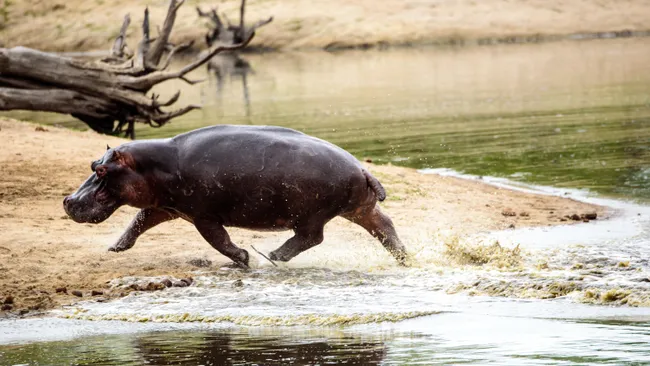Researchers have unveiled a fascinating discovery about hippopotamuses: unlike other four-legged mammals, hippos trot at high speeds and become airborne for “a surprisingly long time.” Despite their massive size, comparable to a medium-sized car, these hefty creatures can lift completely off the ground when reaching top speeds.
This revelation stems from the first comprehensive study of hippo locomotion, published on July 3 in the journal PeerJ. The study reveals that the common hippopotamus (Hippopotamus amphibius) employs a two-beat gait known as a trot, where the diagonal limbs move forward simultaneously. This contrasts with other four-legged animals like elephants, which use a four-beat gait where the sequence is left hind foot, left front foot, right hind foot, and then right front foot.
“Hippopotamuses essentially only trot,” said John Hutchinson, lead author of the study and a professor of evolutionary biomechanics at the Royal Veterinary College in the U.K., in an interview with Live Science. “What’s intriguing is that they maintain this gait across their entire speed range, which is quite unusual.”
While animals such as horses and rhinos typically transition from a trot to a canter or gallop—gaits that include an aerial phase—hippos continue to trot even at speeds up to 15.5 mph (25 km/h). They can remain airborne for 0.3 seconds per stride, which is notable given that hippos can take up to three strides per second.
To investigate hippo movement, Hutchinson and his team analyzed footage of two hippos from a zoo in England and 30 additional animals captured on YouTube. “When you examine a video of a hippo frame by frame, it’s striking to see how they actually lift off the ground and stay airborne,” Hutchinson remarked.
This finding suggests that hippos may possess greater athletic capabilities than elephants, which do not achieve airborne status. The ability to become airborne likely allows hippo limbs to function like springs, storing elastic energy in the tendons and giving their gait a bouncing quality that could be more efficient and potentially faster than remaining grounded. However, the aerial phase does come with drawbacks. It places additional strain on the limbs and muscles, and limits the hippo’s ability to react to its environment during the 0.3 seconds of flight. “Being airborne means you lose control of your surroundings,” Hutchinson explained. “It’s a risky maneuver.”
Many animals achieve airborne phases when moving at full speed, but they rarely do so while trotting due to the stress it imposes on their limbs. Hutchinson suggested that hippos may have evolved to trot because their short limbs and broad bodies would become unstable with a gait that shifts weight onto one side. Trotting helps to evenly distribute their weight on both sides.
There is still much to learn about hippo locomotion, including their maximum speed. Studying hippos is challenging due to their limited presence in captivity and their preference for aquatic environments, where they use a different form of movement called punting—similar to galloping but with the hind feet pushing them along. Understanding hippo locomotion is crucial for both evolutionary research and providing appropriate veterinary care.
